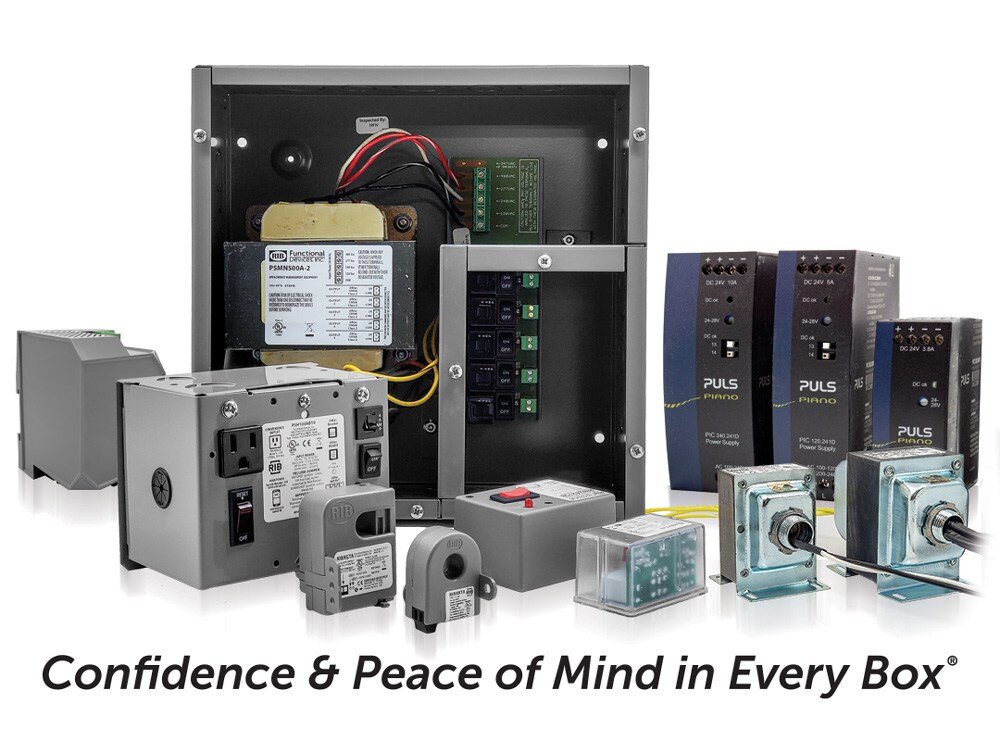How Power Monitoring Improves Safety & Equipment Lifespan
Industrial buildings have many moving parts. Imagine all the machinery and power controls in a busy manufacturing plant. With a potentially crowded production floor and different mechanical systems working together, facility managers must ensure worker safety, equipment longevity, and operational efficiency.
Facility managers can work towards these goals in various ways, including implementing a power monitoring system. We’ve written about the importance of monitoring energy usage to enhance efficiency. Now, let’s explore another critical role power monitoring plays: improving safety and preventing equipment failure.
Here at Functional Devices, we know how essential it is to track energy consumption. If you don’t, you won’t have any diagnostic data to base decisions about your building’s systems. Our relays, power supplies, and Power Meter Kit can help. Contact our team to learn more about designing a power monitoring system that works for you.
The Importance of Power Monitoring in Industrial Settings
Industrial buildings are prime targets for electrical safety hazards because of complex interconnected systems, high-powered machinery, and employees working near equipment. Poor power supplies or inadequate maintenance can easily lead to overloaded circuits and damaged wiring. These issues, in turn, can cause:
- Electrical shocks, fires, and explosions (and potential injury)
- Equipment malfunctions
- Unplanned downtime and production losses
- Reduced lifespan of machinery
Proper power monitoring can help prevent these issues by giving facility managers real-time data on their electrical systems’ performance.
How Power Monitoring Systems Work
At their core, power monitoring systems work to enhance safety and protect equipment by detecting anomalies. They collect real-time voltage, current, power factor, and harmonic distortion data. Then, facility managers can easily interpret any voltage spikes, overloads, and power quality issues from the baseline data.
Additionally, managers can set up power controls to send automated alerts when voltage sags and swells or circuits overload. That way, they can quickly get the information they need without constantly hovering over the data if an issue arises.
Integrating power monitoring into a building management system (BMS) gives managers even more streamlined and centralized control, an important and time-saving step in large, complex buildings.

Power monitoring in industrial settings makes sense from a variety of perspectives. Although we’re focusing on safety and equipment longevity in this post, you can expect to experience all of these benefits.
Without monitoring, equipment can sustain electrical stress without you even knowing. Tracking power consumption gives you the real-time data you need on anomalies to make informed decisions that will not only extend the life of your machinery but also create a safer working environment for your employees.
Best Practices for Implementing Power Monitoring
If your building doesn’t have a power monitoring system and you want to install one, do your due diligence. Follow these basic steps to ensure the best possible outcome:
- Assess needs and define objectives. Conduct an energy audit, determine goals, define target areas, and analyze existing data to create a comprehensive plan.
- Choose the correct devices. Speak with manufacturers, electrical engineers, and other professionals to determine the best monitoring power controls for your building. Ensure they integrate into existing automation and management systems.
- Install the new system. Adequately plan the install around production needs. Install the physical components and configure the necessary software.
- Train and start monitoring. Ensure all relevant employees know how to utilize and maintain the monitoring equipment. Launch the new system and begin collecting data.
- Evaluate, maintain, and optimize. Analyze data regularly, schedule routine inspections, and identify areas for improvement. Make necessary adjustments to enhance safety, equipment longevity, and energy efficiency.
As with any new system, expect a learning curve as you familiarize yourself with new devices and protocols. Then, sit back and enjoy the invaluable real-time data you need to make informed decisions on the health of your building and workforce!
Keep Track With Power Supplies From Functional Devices
A power monitoring system enables facility managers to approach their buildings holistically. If you don’t have power monitoring, now is the time to implement a new system and enhance safety and equipment longevity. Your employees, machinery, bottom line, and operating efficiency will all benefit.
Let the engineers at Functional Devices be your power monitoring guides. We’ve been constructing efficient and streamlined equipment for decades and are committed to providing high-quality products and exceptional customer service. In fact, we test every device before it leaves our production floor to ensure it’s working correctly.
Explore our reliable power monitoring products, and please don’t hesitate to reach out with any questions.
About Functional Devices, Inc.

Leaders in the Industry
The world was a very different place in 1969, when Functional Devices, Inc. was founded by engineer and electronics enthusiast Albert Rittmann, but our commitment to evolution and versatility has allowed us to remain a key player in the building automation and lighting controls industry for over 55 years.
Today, as we embrace emerging technology and lean into the future of building automation, our products are still manufactured in the USA with global materials, and we are still committed to our mission of enhancing lives in buildings and beyond. Back in 1969, Albert could never have predicted the technological advances we live with today, but with the groundwork he laid and the vision of his successors, Functional Devices has adapted and grown into a company that can handle anything.
